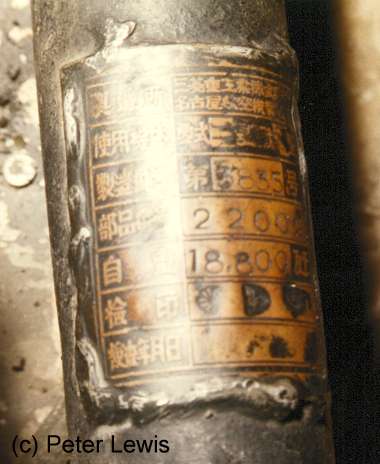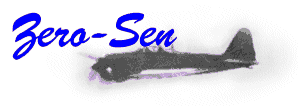Mitsubishi A6M Reisen
'Zero'
Aircraft Series

All text material on this site is
© Peter Lewis
1985, 1999
unless otherwise acknowledged
Identity
The Australian War Museum, Canberra, was in 1985 attempting to build a display A6M2 Model 21 out of three incomplete airframes, and two RAAF personnel, Flight Lieutenant W. Scholz and Flight Sergeant D. Doggett, carried out some dismantling of NZ6000 early in 1985 in order to provide
 technical data for their project. In the course of this work they were
able to identify some panels from other Zeros, and pointed out that
the constructors number could normally be found on the engine firewall
underneath the oil tank.
technical data for their project. In the course of this work they were
able to identify some panels from other Zeros, and pointed out that
the constructors number could normally be found on the engine firewall
underneath the oil tank. Armed with this knowledge, the author and Andrew Wilkins removed the fastening straps around the tank and, not without difficulty, shifted it forward. No information was found in this area, but during reassembly of these components, the manufacturers plate was finally found, welded to an engine bearer.
This plate, which relates to the machine that provided the 'front half' of the aircraft tells us that it was a Mitsubishi-built airframe, constructors number 3835, and had a net weight of 1800.0kg. Unfortunately, the space for date of manufacture was blank.
 The
exterior data panels translated, reads: Type Zero Type Carrier Fighter
Model 22 Manufacturers number Mitsubishi No.3844 Unit attached (painted
over) This panel has been corrupted. There should be a further line
(between the manufacturers number and the unit) giving the manufacturing
date.
The
exterior data panels translated, reads: Type Zero Type Carrier Fighter
Model 22 Manufacturers number Mitsubishi No.3844 Unit attached (painted
over) This panel has been corrupted. There should be a further line
(between the manufacturers number and the unit) giving the manufacturing
date. This evidence confirms rumours that the airframe is built up from components of many damaged machines. We know that it was damaged and repaired at Kara. Shrapnel scars are still visible in the wing interior. The rear fuselage of the Zero was very susceptible to bomb blast damage. The normal method of 'splitting' these aircraft for ground transport or repair was to separate the fuselage just behind the wing root - the cockpit section being an integral part of the wing spar construction. Therefore it would be an easy task to marry the front of one Model 22 Zero with the rear fuselage/tail section of another Zero - not necessarily of identical model. The early production Model 22 had a ground adjustable outset rudder trim tab, while later Model 22 production was fitted with an air adjustable inset tab. This aircraft has the inset tab and also the cockpit control and linkages for this feature.
In summary, we have a composite airframe. The front section is from a late-production Model 22 c/n 3835, and the rear half from a similar Model 22 c/n 3844. Minor componentry identified as coming from other airframes Flight Lieutenant Scholz and Flight Sergeant Doggett are:
LH wing root accesory panel 3278
Both sides gun port panels 3616
Top engine accessory cowl 3616
Top engine cowl 3616
Tail cone 3844
RH gun chute access panel 3616
LH gun chute access panel 3217
Both sides gun blast panel 3616
Also noted were that some panels are of obvious NZ manufacture (probably dating from 1958) and some other detail items (e.g. pitot head) are of English origin.
Zero constructors numbers are a puzzle in themselves, and were deliberately
designed as such. It is a common practice to arrange manufacturer's
number sequences on 'state of the art' military equipment so that
enemy intelligence will find it difficult to deduce the number built
by a given date and thus deduce the rate of production.
Mitsubishi-manufactured A6Ms had a fictitious leading digit. Thus
the first Zero was given construction number 201, the second one 302.
This system was used right through to c/n 3999 (an A6M5). Thus to
obtain the correct number for any Mitsubishi-assembled Zero in this
range, simply ignore the first digit of the serial.
From this point on, Mitsubishi numbers ran in sequence - 4000, 4001,
4002 and so on. To get the correct number, deduct 3000 from the number
quoted.
Other Zero manufacturers - Nakajima, Hitachi and Omura Naval Air Arsenal
- used their own systems. In the case of Nakajima, their A6M2s used
the false leading digit system. When production was switched to the
A6M5, this system was retained but the numbers were restarted from
11 once more.
Unit numbers painted across the fin and rudder were standard on JNAF
aircraft during the Pacific War, but underwent a number of changes.
The system was complex, and the records of its application are often
contradictory.
The prefix, which denotes the unit operating the aircraft, initially
consisted of one or two Japanese characters for units based in Korea
or Japan, a European letter for land-based units in a combat zone,
and a European letter followed by a numeral for carrier-based units.
By the middle of the war, this system had been superseded by a two
or three numerical combination, loosely based on the unit code number.
During the last years of the war, aircraft with either of these systems
were encountered. As aircraft were lost, surviving units amalgamated
both personnel and equipment, and single-numeral prefix codes were
adopted, often as shortened forms of previous prefixes.
The suffix identified the aircraft. Where three digits were used,
the first indicated the mission assigned to the aircraft, e.g. 1 indicated
fighter, 5 carrier operations, 8 reconnaissance, etc. The last two
digits identified the particular aircraft within that unit and mission.
Thus, when an aircraft was transferred, for example, from an operational
fighter unit to a training school, every digit of the fin code would
change.
The fin code of 2-182 on the New Zealand aircraft would denote a fighter
mission, not carrier or reconnaissance. In November 1943 land-based
units at Rabaul which operated Zeros were 201 Kokutai (at one stage
coded W1-), 204 Kokutai ( T2- ) 251 Kokutai ( V- ) and 582 Kokutai
( Q- ). About 1944, these units adopted a single-numerical unit code,
known examples being 6-171 7-119 9-151 7-101 2-119 and 2-116. Zero
6-171 is know to have belonged to 204 Kokutai, so presumably the 2-
prefix was a code for one of the other three units, and the New Zealand
aircraft was at some stage assigned to that unit.
